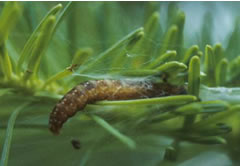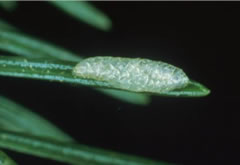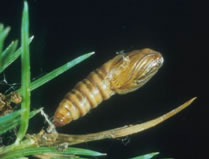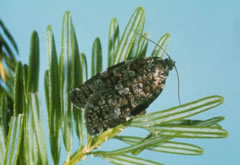Spruce budworm (factsheet)
We have archived this page and will not be updating it.
You can use it for research or reference.

Spruce budworm
French common name: Tordeuse des bourgeons de l'épinette
Scientific name: Choristoneura fumiferana Clemens
Order: Lepidoptera
Family: Tortricidae
Distribution
A native species, the spruce budworm is considered the most serious pest of fir and spruce forests in eastern North America. Its range coincides with that of fir and white spruce, and increasingly black spruce.
The spruce budworm causes the most damage in overmature fir stands. White, black and red spruce are also defoliated. Other species such as tamarack can be consumed during outbreaks.
Hosts in Canada
Hosts in Canada
Principal hosts in Canada
Balsam fir, white spruce, red spruce, black spruce
Other hosts
Eastern hemlock, jack pine, Norway spruce, tamarack
Life history

Cluster of spruce budworm eggs
In July and August, adult moths mate and females deposit their eggs in clusters of 10 to 150 on the needles of host trees, preferring those exposed to sunlight. Newly hatched first instar larvae moult into second instars and move toward the interior of the crown in search of suitable overwintering sites. They construct silken shelters, called hibernacula, in tree crevices, within which they spend the winter. In the spring, overwintering second instar larvae emerge from diapause and disperse again in search of new foliage on which to feed. They moult into third instars, establish themselves on current-year foliage in which they construct larval nests and proceed to feed. Fourth, fifth and sixth instar larvae feed voraciously on new foliage and defoliate trees at high densities. Pupation occurs in late June and July, and adults emerge to repeat the cycle.
Ecology
Spruce budworm population cycles are characterized by epidemic and endemic phases, and outbreaks occur every 30 to 40 years. The causes of outbreaks are still debated. Suitable climatic factors, such as consecutive warm, dry springs, and biotic factors such as homogeneous stands of host trees and changes in natural enemy abundance, have been considered in explaining the onset of outbreaks. Population collapse is attributed to resource depletion, disease and an increase in the impact of natural enemies.
Attack and damage

Spruce budworm pupa
Spruce budworm damage appears in May, when third instar larvae begin to feed. Evidence of a spruce budworm infestation includes defoliation of current-year shoots and the presence of larval nests and excrement. In addition, if an infested branch is disturbed, large numbers of larvae spin off the tree with strands of silk.
Defoliation begins at the top of the tree and quickly progresses downwards. Needles are partially or completely consumed. Spruce budworm larvae also feed on male (pollen) flowers and cones. During outbreaks, the larvae may destroy all of the cones.

Spruce budworm moth
Severely affected stands turn a rust colour as a result of dried-out needles held by strands of silk spun by the larvae. In the fall, most dead needles fall off. Defoliated stands take on a greyish appearance.
A single year of defoliation weakens the tree, making it more susceptible to attack by other insects. Defoliation over a few consecutive years causes tree growth loss. If severe defoliation continues uninterrupted over several years, many trees will die, while others will continue to decline for several years, even after the end of the infestation. Fir trees will die after four to five consecutive years of severe defoliation.
Status in Canada
Three outbreaks have occurred in eastern North America since the beginning of the 20th century. The last outbreak occurred in eastern Canada between 1966 and 1992, affecting over 50 million hectares. A new outbreak of about 3000 hectares was detected in Quebec, on the north shore of the St. Lawrence River in 2006 and the area affected has been doubling each year ever since. By 2013, over 3.2 million hectares of forest in Quebec alone has suffered moderate to severe defoliation.
Link
References
References
Nealis, V.G., and J. Régnière. 2004. Insect-host relationships influencing disturbance by the spruce budworm in a boreal mixedwood forest. Canadian Journal of Forest Research 34: 1870–1882.
Régnière, J., and V.G. Nealis. 2007. Ecological mechanisms of population change during outbreaks of the spruce budworm. Ecological Entomology 32: 461–477.
Royama, T. 1984. Population dynamics of the spruce budworm Choristoneura fumiferana. Ecological Monographs 54: 429–462.
Page details
- Date modified: